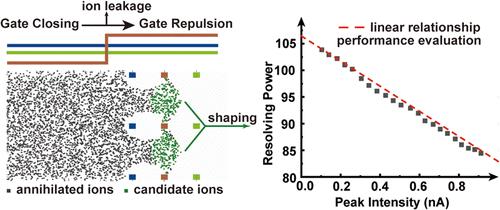离子迁移率光谱中基于离子泄漏控制的改进离子群成形
IF 6.7
1区 化学
Q1 CHEMISTRY, ANALYTICAL
引用次数: 0
摘要
在离子迁移率光谱(IMS)中,离子门是控制离子流动的关键,对检测灵敏度和分辨率有重要影响。尽管有各种优化方法,但需要一个明确的方法来定义离子门的性能极限。本研究提出了低离子量下峰值强度(Ip)与分辨能力(Rp)之间的线性关系,并将其作为评价优化水平的参考。三态门(TSG)可以精确地研究这种Ip-Rp关系,但TSG的离子泄漏破坏了对窄离子群的控制,从而限制了Rp。在分析离子泄漏原因的基础上,提出了一种去除开闸相的预成型方法来精确控制离子注入。该方法利用离子泄漏来提高Rp,同时确保Ip和Rp之间的线性。保持线性意味着避免过多的离子损失和形状畸变,最终导致最佳的分辨率。仿真和实验表明,精确的电压调节可以有效地减少离子泄漏,使分辨能力提高50%(最大可达106),而相应的信号强度下降遵循Ip-Rp线性关系。该方法在不改变Ip-Rp组合基本关系的前提下,扩大了Ip-Rp组合的可达范围,减少了区分,为优化IMS中的栅极性能建立了一种新的评价方法。本文章由计算机程序翻译,如有差异,请以英文原文为准。

Achieving Improved Ion Swarm Shaping Based on Ion Leakage Control in Ion Mobility Spectrometry
In Ion Mobility Spectrometry (IMS), ion gates are essential for controlling ion flow, significantly impacting detection sensitivity and resolution. Despite various optimization methods, a clear approach is needed to define the performance limits of ion gates. This study proposes a linear relationship between peak intensity (Ip) and resolving power (Rp) at low ion quantities, introducing it as a reference for evaluating the optimization level. The Tri-State gate (TSG) enables the accurate study of this Ip–Rp relationship, but ion leakage of TSG disrupts control over narrow ion swarms, thereby limiting Rp. After the causes of ion leakage were examined, a preshaping method that removes the gate-opening phase was proposed to precisely control ion injection. This method leverages ion leakage to improve Rp while ensuring the linearity between Ip and Rp. The preserved linearity means avoiding excessive ion loss and shape distortion, ultimately leading to optimal resolving power. Simulations and experiments demonstrate that precise voltage adjustments effectively minimize ion leakage, enhancing resolving power by 50% (reaching a maximum of 106), while the corresponding decrease in signal intensity follows the Ip–Rp linear relationship. This approach expands the accessible range of Ip–Rp combinations without altering their fundamental relationship, reduces discrimination, and establishes a new evaluation method for optimizing ion gate performance in IMS.
求助全文
通过发布文献求助,成功后即可免费获取论文全文。
去求助
来源期刊

Analytical Chemistry
化学-分析化学
CiteScore
12.10
自引率
12.20%
发文量
1949
审稿时长
1.4 months
期刊介绍:
Analytical Chemistry, a peer-reviewed research journal, focuses on disseminating new and original knowledge across all branches of analytical chemistry. Fundamental articles may explore general principles of chemical measurement science and need not directly address existing or potential analytical methodology. They can be entirely theoretical or report experimental results. Contributions may cover various phases of analytical operations, including sampling, bioanalysis, electrochemistry, mass spectrometry, microscale and nanoscale systems, environmental analysis, separations, spectroscopy, chemical reactions and selectivity, instrumentation, imaging, surface analysis, and data processing. Papers discussing known analytical methods should present a significant, original application of the method, a notable improvement, or results on an important analyte.
 求助内容:
求助内容: 应助结果提醒方式:
应助结果提醒方式:


